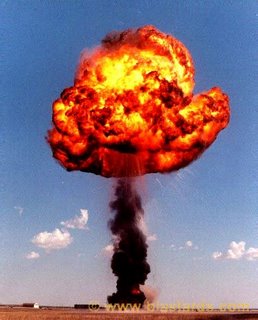Thursday, April 13, 2006
Atomic Accidents
 As we have a fit about the outside possibility that Iran might acquire nuclear arms in the next ten years, a more dangerous threat can be found in our own backyard. We all know these weapons are dangerous, but were you aware of just how many goofs and blunders there have been? Are you aware of just how close we've "accidently" been to the brink of nuclear annihilation? It is now known that the NAVY routinely covered up such incidents:
As we have a fit about the outside possibility that Iran might acquire nuclear arms in the next ten years, a more dangerous threat can be found in our own backyard. We all know these weapons are dangerous, but were you aware of just how many goofs and blunders there have been? Are you aware of just how close we've "accidently" been to the brink of nuclear annihilation? It is now known that the NAVY routinely covered up such incidents:A May 8, 1984, directive from Admiral William Crowe, then commander in chief in the Pacific, ordered commanders "to recover or remove, if at all practical, all evidence of the nuclear weapon accident or significant incident as expeditiously as possible" and " a denial should characterize the accident or incident as a non-nuclear event."What follows is a list of six such "accidents" that can be found in a wonderful book called "Weird History 101" by Richard Stephens. I happen to think real nuclear weapons are more dangerous than imaginary ones. Read the following and let me know what you think:
1. In July 1956, a B-47 aircraft plowed into a storage igloo 20 miles outside of Cambridge, England. The plane's jet fuel burst into flames almost immediately, but for some reason didn't ignite the contents of the igloo. A lucky thing, too--it contained three Mark 6 nuclear bombs.
2. In 1958, a B-47E accidently dropped a nuclear bomb into Mars Bluff, South Carolina, family's vegetable garden. The bomb didn't explode, but the impact damaged five houses and a church. Air Force officials "apologized."
3. In 1961, a B52 dropped two 24-megaton bombs on a North Carolina farm. According to one physicicist: "Only a single switch prevented the bombs from detonating."
4. In 1966, another B-52 carrying four 20-megaton bombs crashed in Palomares, Spain--with one of the bombs splashing into the Mediterranean Sea. It took the U.S. 6th fleet--using 33 ships and 3,000 men--several weeks to find the missing bomb.
5. In 1980, a repairman working on a Titan II missile in Arkansas dropped a wrench--which bounced off the floor, punctured the missile, and set off an explosion that blew the top off the silo and threw the warhead 600 feet into the air.
6. Did June 3, 1980, seem tense to you? It did to the Strategic Air Command in Omaha, Nebraska. Their computers detected a Soviet submarine missile attack in progress. Within minutes, more than 100 B-52s were in the air, but the SAC soon called off the counterattack--the computers had made a mistake. The culprit: a $0.46 computer chip. Three days later the same mistake happened again. During an 18-month period NORAD had 151 false alarms caused by computer errors--4 of which put bomber and missile crews on alert.
| +Save/Share | |
FEATURED QUOTE
No subject for immortal verse
That we who lived by honest dreams
Defend the bad against the worse."
-- Cecil Day-Lewis from Where Are The War Poets?
ABOUT US
RECENT POSTS
ARCHIVES
RECENT COMMENTS
[Tip: Point cursor to any comment to see title of post being discussed.]
SEARCH THIS SITE
BLUE'S NEWS
ACT BLUE
BLUE LINKS
Environmental Links
Gay/Lesbian Links
News & Media Links
Organization Links
Political Links
Religious Links
Watchdog Links
BLUE ROLL
MISCELLANEOUS














